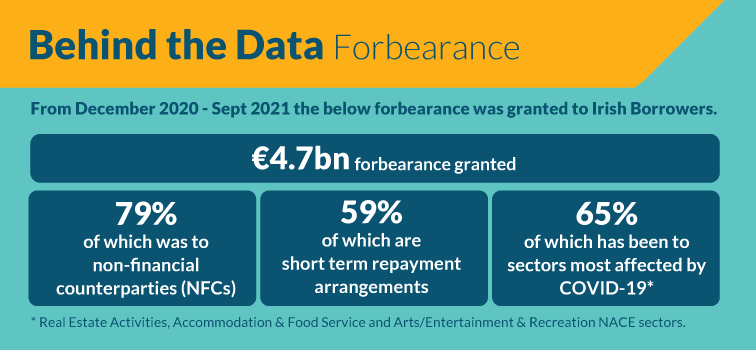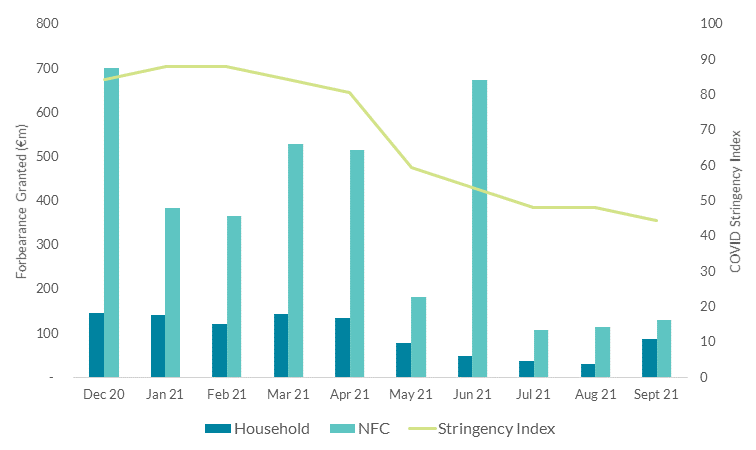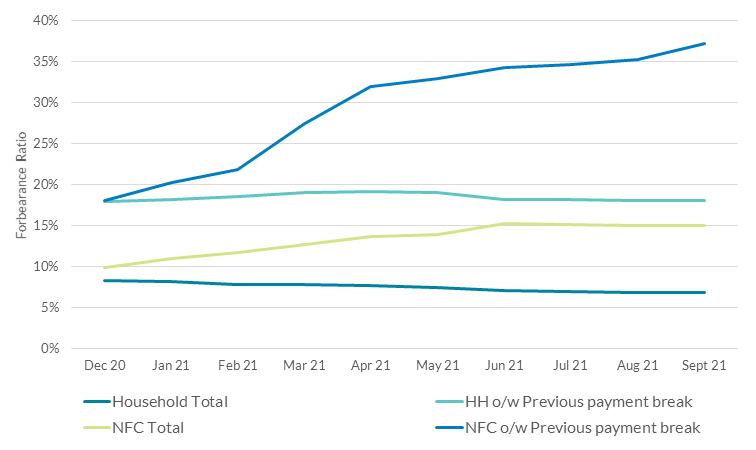Behind the Data

Forbearance during the COVID-19 crisis in 2021: Who has needed lenders’ support?
Authors Stephen Sweeney and Allan Kearns*
December 2021
Irish retail banks granted the majority of loan forbearance to SME/corporate borrowers in sectors most affected by the pandemic over 10 months to September 2021. Forbearance agreements have focused mainly on short-term solutions with highest demand in H1 2021.
The speed and scale of the economic shock caused by COVID-19 was unique, and heavily impacted on household incomes and business revenues, particularly in sectors most affected by containment measures. The impact on business and individuals was mitigated by large-scale financial supports from the governments and creditors including income support schemes, tax and rent holidays and payment breaks from lenders. As discussed in the latest Financial Stability Review, the full extent of household and business distress will, however, only be apparent as these supports are phased out. As lender payment breaks ended in late-2020 and early-2021, focus shifted from wide-ranging COVID-19 payment breaks to case-by-case assessment and management of any continuing borrower distress. Over 2021, additional but more specific lending forbearance agreements continue to be relevant in the Irish market to support affected borrowers and minimise wider economic impacts. The nature of lender forbearance measures can vary, but includes measures to reduce cash-flow pressure in a business (e.g. interest only or term extensions) to easing loan covenant conditions which provide greater financial flexibility to the borrower.
This “Behind the Data” uses new data on forbearance granted by Irish retail banks to Irish firms and households. The data illustrates that over the 10-month sample period to end-September 2021, retail banks have issued forbearance to borrowers on €4.7bn of loans, of which almost 80 per cent has been to corporates and SMEs. This represented 12% and 10% of their outstanding corporate and SME loans respectively.
The Data
Forbearance is a support mechanism granted by lenders to borrowers who require support. While initial forbearance in response to the Covid-19 crisis has typically been associated with payment breaks, a wide range of options are available depending on specific situation and borrower circumstances. The objective is typically to return to sustainable repayments at the end of the forbearance agreement.
The Central Bank of Ireland commenced a data collection with Irish retail banks on distressed debt in 2021. This includes data on the flow of loans to Irish resident companies and households into distress and requiring forbearance. The new forbearance flow data is one indicator used to monitor emerging distress among borrowers, financial conditions in the economy, as well as informing supervisory engagement with banks.
The data permit us to observe the forbearance agreements by type of loan, borrower economic sector and whether the recipients received a European Banking Authority (EBA) compliant COVID-19 payment break in 2020. This data does not capture if a borrower was already in another forbearance arrangement at the time of granting the new forbearance arrangement during our study period.
4 out of 5 forbearance granted were to NFCs in the period

We measure the scale of forbearance granted as the value of the loan receiving forbearance. In total, €4.7bn of forbearance was granted to Irish borrowers in the 10-months to end-September 2021. This equates to 4% of the consolidated value of loans and advances to Irish households (HH) and non-financial corporates (NFC) in the retail banking sector.
This scale of the new forbearance measures is significant when compared against the pre-COVID-19 period. At end-2019, €3.7bn of the stock of NFC loans were classified as forborne, rising to €5bn by end-2020 and €8.3bn by end- September 2021. The headline trend in the household loan portfolio sector is different, with a lower level of loans in forbearance arrangements than pre-COVID but this reduction is driven in large part by bank loan sales in the period.
NFCs have received 79% (by value) of new forbearance granted by banks. The scale of the forbearance granted to NFCs is evident with 12% and 10% for corporate and SMEs loan book receiving forbearance in the 10 month period (Chart 1). Households have required some forbearance but the scale is much lower than seen in the corporate or SME loan portfolios. The lower demand for forbearance among households in our sample period may be explained by three factors. First, payment breaks for households typically expired in 2020 compared to late-2020 or early-2021 for NFCs. Second, this dataset does not include mortgage or personal loans held by other financial firms, such as retail credit firms and credit servicing firms where a large share on non-performing mortgages are now held. Finally, the Financial Stability Review 2021:II outlined how pandemic policy support has offset the liquidity shock facing households, with liquidity buffers growing in aggregate during the pandemic.
Chart 1 - Loan forbearance granted by borrower type (Dec 20 - Sept 21)
.png?sfvrsn=78ff921d_2)
Source: Central Bank of Ireland
Notes: Forbearance granted % of Total Loans is the cumulative sum of all forbearance granted in the sample period divided by outstanding value of the total stock of loans as at September 2021.
The rate of new forbearance granted slowed in Q3. The average monthly forbearance in the first 6 months of 2021 was €550mn per month, compared to €509mn over the entire third quarter of 2021 (Chart 2). This decline in forbearance granted is likely impacted by the timing of when payment breaks expired, the continuation of government supports and the easing of COVID-19 related restrictions throughout the summer. Forbearance may pick up as existing forbearance arrangements expire and if the economic conditions deteriorate.
Chart 2 - Forbearance granted by Month and COVID Stringency Index (RHS)*

Source: Central Bank of Ireland and Oxford University COVID Stringency Index.
Forbearance has afforded short-term relief to borrowers
The data show that 59% of forbearance solutions are categorised as short-term repayment arrangements (Chart 3), with the remaining 41% classified as “other”. The predominant short-term repayment arrangements are interest-only or repayment moratoria. These arrangements ease cash-flow pressures in borrowers by temporarily reducing the loan repayment to the lender. The “other” forbearance category is predominantly covenant waivers and term extensions. Covenant waivers or adjustments mostly relate to financial covenants and allow firms to temporarily be in breach of terms attached to the loan, e.g. a debt to equity ratio not exceeding a particular threshold. This forbearance allows NFCs, who have demonstrated that they are otherwise not unlikely to pay, to remain classified as performing or non-defaulted, thus avoiding a negative impact on the borrower’s credit history and a negative impact on banks’ capital and provision costs. However, these type of arrangements do not typically result in an improvement in the borrower’s ability to repay the debt over the long term in the event that the adverse conditions persist.
Longer-term or deeper restructures (e.g. split loans) are not a feature of recent forbearance granted. This could reflect the continuing uncertain outlook that borrowers face, the restrictions borrowers face as a result of the pandemic and the level of government policy support in place for affected borrowers.
Table 1 - Forbearance Arrangements by Borrower Type
|
Mortgages |
Household Other |
SMEs |
Corporates |
Total |
| Short Term Repayment Arrangements
|
67% |
58% |
52% |
63% |
59% |
| Of Which:
|
|
|
|
|
|
| Interest Only
|
48% |
37% |
60% |
55% |
55% |
| Moratorium
|
21% |
42% |
29% |
40% |
32% |
| Reduced Repayment
|
30% |
18% |
11% |
4% |
13% |
| Other Temporary
|
0% |
3% |
0% |
0% |
0% |
| Other Forbearance
|
33% |
42% |
48% |
37% |
41% |
| Of Which:
|
|
|
|
|
|
| Covenant Waiver
|
0% |
0% |
45% |
60% |
42% |
| Term Extension
|
28% |
48% |
27% |
30% |
28% |
| Bullet Repayment
|
27% |
0% |
18% |
0% |
13% |
| Arrears Cap
|
21% |
7% |
0% |
0% |
4% |
| Split Loan
|
11% |
2% |
0% |
0% |
2% |
| Other Permanent
|
13% |
44% |
9% |
11% |
11% |
Source: Central Bank of Ireland
Forbearance granted to Covid-19 vulnerable sectors
A sectoral analysis of forbearance granted for NFCs highlights the uneven nature of the impact of the pandemic on borrowers operating across different economic sectors. The data in Chart 4 show the details of the type of forbearance measures for the top 5 impacted economic sectors. By value of loans that received forbearance, the top three economic sectors received forbearance are the Real Estate Activities, Accommodation & Food Service and Arts, Entertainment & Recreation sectors. These sectors account for 83% of forbearance granted to NFCs during the period. The impact on the Accommodation & Food Services sector is particularly evident with 41% of the loan book by value entering a forbearance arrangement in the 10-month to end-September.
There is diversity in the nature of the forbearance granted between sectors. Accommodation and Food services has received a very high proportion of short term forbearance arrangements (Chart 4). Borrowers in the Real Estate Activities sector have availed of a mixture forbearance arrangements of short term repayment arrangements, term extensions, covenant waivers and bullet repayments.
Table 2 - Forbearance granted by NACE Sector
|
Real Estate Activities
|
Accommodation, Food Service Activities |
Arts Entertainment, Recreation |
Agriculture, Forestry, Fishing |
Wholesale, Retail Trade |
Other Sectors |
| Forbearance Granted (€m)
|
1510 |
1404 |
137 |
62 |
134 |
454 |
| as proportion of total granted
|
41% |
38% |
4% |
2% |
4% |
12% |
| Short Term Repayment Arrangements
|
35% |
91% |
41% |
20% |
32% |
40% |
| Of Which:
|
|
|
|
|
|
|
| Interest Only
|
31% |
69% |
61% |
43% |
42% |
56% |
| Moratorium
|
53% |
27% |
29% |
41% |
45% |
35% |
| Reduced Repayment
|
16% |
4% |
10% |
16% |
14% |
9% |
| Other Temporary
|
0% |
0% |
0% |
0% |
0% |
0% |
| Other Forbearance
|
65% |
9% |
59% |
80% |
68% |
60% |
| Of Which:
|
|
|
|
|
|
|
| Covenant Waiver
|
60% |
29% |
0% |
9% |
0% |
67% |
| Term Extension
|
17% |
51% |
98% |
30% |
50% |
29% |
| Bullet Repayment
|
18% |
0% |
0% |
0% |
0% |
0% |
| Arrears Cap
|
0% |
1% |
0% |
3% |
0% |
0% |
| Split Loan
|
0% |
0% |
0% |
1% |
0% |
0% |
| Other Permanent
|
5% |
19% |
2% |
58% |
49% |
3% |
| Forbearance Granted as proportion of Total Loans
|
14% |
41% |
24% |
2% |
4% |
4% |
Source: Central Bank of Ireland
Notes: Forbearance granted % of Total Loans is the cumulative sum of all forbearance granted in the sample period divided by outstanding value of the total stock of loans for that sector as at September 2021.
Borrowers with expired EBA payment breaks have had higher recourse to forbearance
A previous “Behind the Data” publication “COVID-19 Payment Breaks – who continues to avail of them?” showed that at its peak in mid-2020, around €27bn or approximately 13% of all outstanding loan balances had an EBA compliant payment break in place. Approximately 90% returned to full repayments on existing or extended terms when the payment break expired. The remaining 10% required further support. The new data indicates that some borrowers, who initially returned to their originally repayment schedule, have subsequently needed new forbearance supports in 2021. These borrowers were also more likely to require support than borrowers who didn’t initially avail of EBA payment breaks in 2020.
The proportion of all loans with expired EBA payment breaks subsequently in forbearance has risen from 18% in December 2020 to 25% in September 2021. The different dynamics in the household and NFC loans are again clear with the forbearance ratio for household borrowers remaining stable throughout 2021, while the forbearance ratio for NFC loans with expired EBA payment breaks has doubled to 37%.
Chart 5 - Forbearance Ratio over time

Source: Central Bank of Ireland
Note: Forbearance ratio is the stock of forborne loans divided by the total value of loans outstanding in that time period.
Conclusion
New data reported by retail banks illustrate that that Irish companies have required continued and significant new forbearance from Irish retail banks throughout 2021. More specifically, the sectoral data show that the impact of the crisis is largely contained in the Real Estate, Accommodation & Food service and Arts, Entertainment & Recreation sectors.
The rate of new forbearance granted slowed in the third quarter of 2021 following high levels of activity in the first half of the year. This reflects the expiry of initial supports put in place by banks in 2020 in conjunction with the wider economic re-opening throughout summer 2021 and the related stabilisation for many borrowers in terms of their financial outlook. The level of forbearance for certain sectors of NFCs that had a payment break indicates that this remains a vulnerable cohort that requires close monitoring and proactive management by the lenders.
The type of forbearance granted reflects the type of crisis that the COVID -19 pandemic has created. Against a particularly uncertain economic outlook, there has been significant use of interest only, moratoria, covenant waivers and term extensions. As forbearance arrangements expire, it is important for lenders to assess individual borrower circumstances, and to offer flexible and sustainable solutions to affected but viable borrowers, where appropriate.
Lenders need to continue to ensure the timely and accurate recognition of any deterioration in the risk profile of distressed borrowers. This is a key risk management control that allows firms to both identify those vulnerable borrowers such that the appropriate level and type of support can be proactively assessed, and that the extent of their underlying credit risk is prudently accounted for and classified.
*Email [email protected] if you have any comments or questions on this note. Comments from Adrian Varley, Rory McElligott, Trevor Fitzpatrick, Michael Smyth, Aisling Menton, Paul Jennings, Sean Fitzpatrick, Triona Forde and other colleagues are gratefully acknowledged. The views expressed in this note are those of the authors and do not necessarily reflect the views of the Central Bank of Ireland or the ESCB.
See also: